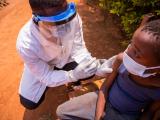Jun 22, 2012 (CIDRAP News) – The US Centers for Disease Control and Prevention (CDC) yesterday unveiled two new tools designed to boost pandemic preparedness: an inventory of H5N1 avian influenza genetic changes and a system the CDC and its partners are developing to help evaluate the threat from flu viruses circulating in animals.
The CDC posted details about the new tools on its Web site yesterday, the same day highly anticipated findings from the second of two controversial H5N1 transmission studies—the one from a group at Erasmus Medical Center in the Netherlands—was published in Science.
Tom Skinner, a spokesman for the CDC, told CIDRAP News that the CDC waited for the publication of the study from Erasmus, led by Ron Fouchier, PhD, to unveil the H5N1 genetic changes inventory. "The inventory has been in the works for a while, and we wanted it to be as complete and up to date as possible when we first posted to include the Fouchier sequences," he said.
The CDC said the H5N1 changes inventory is geared toward those conducting influenza surveillance in humans and animals, as well as those conducting research on H5N1. The inventory is a list of amino acid changes grouped by viral protein. Listed wth each mutation are the phenotypic consequences, the virus isolate tested, and selected literature references.
The World Health Organization (WHO) Collaborating Center for Influenza at the CDC, along with international partners, developed the inventory and will update it periodically and apply date stamps when it adds new mutations, the CDC said.
The Influenza Risk Assessment Tool (IRAT) is designed to help public health officials prioritize their pandemic preparedness activities, such as developing new vaccines and boosting surveillance, according to background information from the CDC's Web site.
The CDC emphasized that the tool isn't intended to predict pandemics or limit input from experts. "Flu is unpredictable, as are future pandemics," it said.
IRAT considers two dimensions in estimating thethe pandemic risk associated with a flu virus: emergence, or the risk of a novel virus spreading easily and efficiently in humans, and public health impact, meaning the possible severity and burden on society.
The tool allows flu experts to evaluate novel viruses using 10 scientific criteria, such as genomic variation and antigenic relationship to vaccine candidates, grouped into three categories: properties of the virus, attributes of the population, and ecology and epidemiology of the virus. Each criterion is weighted statistically as it relates to each of the two scenarios. Composite scores allow experts to rank and compare viruses, based on their potential pandemic risk.
The CDC said IRAT is also designed to help identify information gaps, transparently document the process used to make management decisions, provide a flexible way to update risk assessments, and serve as a communication tool for policymakers and the flu community.
In related developments, the CDC posted and updated several H5N1 resources for professionals over the past 2 days, including background on prevention and treatment, H5N1 in people, H5N1 in birds and other animals, past avian influenza outbreaks in North America, interim lab testing guidance, and guidance for following-up on contacts of people with suspected infections.
See also:
Jun 21 CDC H5N1 avian influenza genetic changes inventory
Jun 21 CDC Influenza Risk Assessment Tool background
Jun 21 CDC update on H5N1 prevention and treatment
Jun 21 CDC update on H5N1 in humans
Jun 21 CDC update on H5N1 in birds and other animals
Jun 21 CDC update on the current H5N1 situation
Jun 21 CDC update on past avian influenza outbreaks in North America
Jun 22 CDC update on H5N1 lab testing guidance
Jun 22 CDC guidance on follow-up of suspected H5N1 case contacts


















